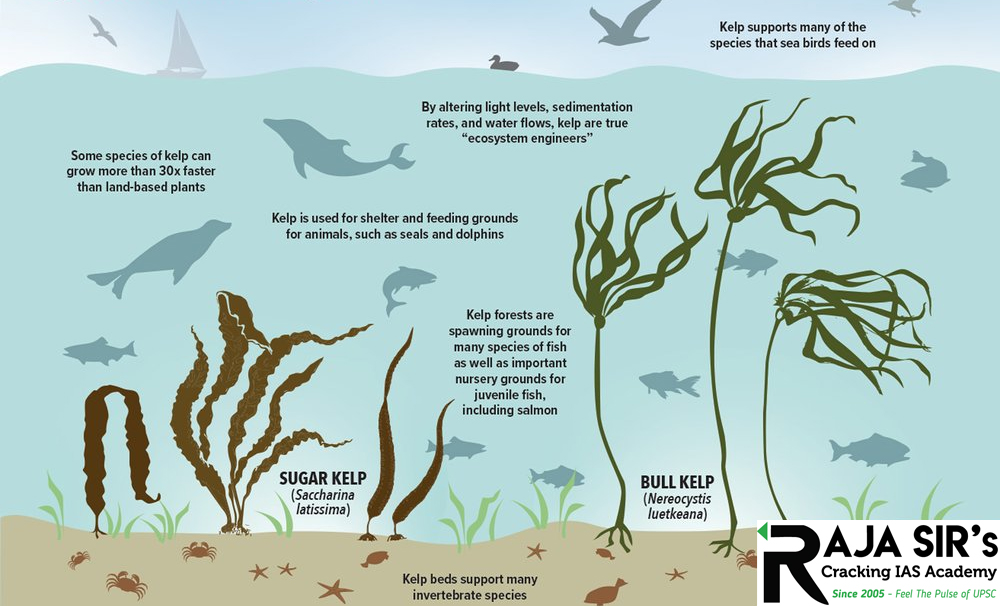- Home
- Prelims
- Mains
- Current Affairs
- Study Materials
- Test Series
Help the Kelp
Kelp forests
- Kelp are large brown algae
- These are underwater ecosystems found in cool, nutrient rich, shallow waters that are close to the shore
- Many organisms use the thick blades as a safe shelter for their young from predators or even rough storms.
- Some kelp species can measure up to 150 feet (45 m) long. If living in ideal physical conditions, kelp can grow 18 inches (45 cm) a day.
- Sea urchins can destroy entire kelp forests at a rate of 30 feet (9 m) per month by moving in herds. Sea otters play a key role in stabilizing sea urchin populations so that kelp forests may thrive.
- Ecklonia radiata is the dominant and most widely distributed Laminarian kelp in the southern hemisphere
- New populations were found in shallower and cooler winter months with temperatures around 20°C
- Kelp can sometimes persist at lower latitudes, aided by cool water upwelling or in deep-water refugia where they are protected by thermocline (the transition layer between the warmer mixed water at the surface and the cooler deep water below).

Distribution of Kelp forest
- Kelp forests have been observed throughout the Arctic by the Inuit. The Canadian Arctic alone represents 10 per cent of the world’s coastlines.
- They have adapted to severe conditions. These cool water species have special strategies to survive freezing temperatures and long periods of darkness and even grow under sea ice.
- In regions with cold, nutrient-rich water, they can attain some of the highest rates of primary production of any natural ecosystem on Earth.
- Between Ellesmere Island and Labrador, as well as along the coasts of Lancaster Sound, Ungava Bay, Hudson Bay, Baffin Bay, and Resolute Bay in Hudson Bay and eastern Canada, kelp forests have been scientifically documented.
Significance
- Kelp forests provide food and shelter for thousands of species such as seals, sea lions, whales, sea otters, gulls, terns, snowy egrets, great blue herons, cormorants, and shore birds.
- Kelp forests provide underwater habitats to hundreds of species of invertebrates, fishes, and other algae and have great ecological and economic value.
- Loss of kelp forests will also lead to a decline of the unique biodiversity that they support
- There is high evolutionary diversity in the low-latitudes as many marine organisms were only able to persist within ice-free refuge areas at lower latitudes during the Ice Age
- Giant kelp is harvested from kelp forests and used as a binding agent in products like ice cream, cereal, ranch dressing, yogurt, toothpaste, lotion and more.
Threat
- Thawing permafrost and crumbling Arctic coasts are dumping sediments into coastal waters at alarming rates, which blocks light and could limit plant growth.
- The run-off from melting glaciers will also lowers salinity and increase turbidity, which impacts young kelp.
- Destructive fishing practices, coastal pollution, and accidental damage caused by boat entanglement are known to negatively affect kelp forests.
- Sea urchins can destroy entire kelp forests at a rate of 30 feet (9 m) per month by moving in herds. Sea otters play a key role in stabilizing sea urchin populations so that kelp forests may thrive.









 Latest News
Latest News
 General Studies
General Studies